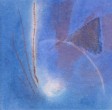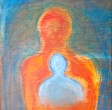Finding One’s True Self at the Altar
Spiritual seekers of all traditions and times strive to access a realm, which lies beyond our everyday reality. Often the entry into this realm is connected with an altered or extended experience of the self. A transformed self-consciousness goes hand in hand with an understanding of the spiritual world. Accordingly living with the Act of Consecration of Man and the other sacraments of the Christian Community very often gently changes over time the relationship to the world and to our selves. Our understanding of the spiritual is deepened. What is happening at the altar and in our communities that allows this to take place?
Before we can answer this question it might be helpful to look at other traditions and their way to change the experience of the self. Following old teachings the Zen master Guishan Lingyu asked his pupils to contemplate a riddle:
“Tell me in one word what your original being was before your parents gave you birth and prior to your capacity to discriminate things.”
In their effort to answer, the students will be led back in time to the origins of their existence. Questions like this might come up: Where were we before we started thinking? Where were we before we received a physical body? Did your experience of the self exist before you were born?
Going back to the origins in the described way can bring us to a point where we might feel that our individual every day thinking does not lead us anywhere but into nothingness. We might conclude that going back in time we did not exist at all as an individual self; or that we were an unidentifiable integral part of a “great cosmic consciousness” before we were born. As a result the experience of our self may be perceived as a transient illusion, which will not lead us to higher knowledge.
Another way to gain a new relationship to our selves is, not by going back to our origins like the Buddhist teacher suggests, but by being aware of our selves in the present moment. The contemporary spiritual teacher Eckhart Tolle describes this as a life changing personal experience:
“For years my life alternated between depression and acute anxiety. One night I woke up in a state of dread and intense fear, more intense than I had ever experienced before. Life seemed meaningless, barren, hostile. It became so unbearable that suddenly the thought came into my mind, “I cannot live with myself any longer.” The thought kept repeating itself several times. Suddenly, I stepped back from the thought and looked at it, as it were, and I became aware of the strangeness of that thought: “If I cannot live with myself, there must be two of me – the I and the self that I cannot live with.” And the question arose, “Who is the ‘I’ and who is the self I cannot live with?”
Tolle describes how with this experience of an “observing uninflected self “ his “unhappy everyday self” collapsed and stopped to play the major role in his life. He calls the newly found liberating entity in himself the “I AM”.
In this spiritual experience the suffering “everyday-self” becomes a stepladder to a new awareness of a second self, which is always there. It was just not perceived before. The “lower self” starts to acknowledge the “higher self” as a living reality and authority.
Initially in a very similar way the Sacraments can promote a transforming experience. Central is here the celebration of the Act of Consecration of Man. This is a collaborative happening, in which everybody present is equally invited to engage in the process by being fully there, with all senses, awake in the present moment. The foundation of the Act of Consecration is a sensual experience, honoring the presence of our so-called “lower self”. But when the first words are spoken another layer is added to our participation: “Let us worthily fulfill the Act of Consecration of Man…” The participant will soon realize that this is a challenge. Distracting thoughts come and go; the feeling of tiredness can be overwhelming. But if the will and interest is there to contribute to the service actively than sooner or later a living awareness of the self will develop which is comparable to the experience of Eckhart Tolle. One can realize that there are “two of me” – “the self which distracts itself” and “the self, which can tune in, which feels perfectly at one with what is said.” This realization might be accompanied with the feeling that through attending the Act of Consecration inner turbulences are calmed down and a growing sense for one’s owns life direction is developed. This is because- like Tolle – we consciously or unconsciously also start to live more intensely with the question: “Who is the I? The true self? And the Act of Consecration of Man starts to offer answers. The perception of our lower self, our higher self and the being of Christ start to merge in our experience. That can be very inspiring because it gives us ideas about our future as humanity and individuals. Where are we going? What am I called to do? So instead of leading us solely to the origins of our existence all sacraments invite us to see the future aspects of human evolution as well. We engage in a process in which we are allowing our every day consciousness to have a conversation with the eternal in us.As observers of this conversation we learn to embrace and to nourish in us the Christ consciousness, which lives in the renewed sacraments.
This inner conversation can be further deepened in the Sacrament of Consultation.
Lindy Lee, Sources of the Self, 2006
mailto:oxley9@rslynoxley9.com.au, oxley9@rslynoxley9.com.au
See Original Teachings of Ch’an Buddhism [trans. Chang Chung-Yuan] Pantheon Books, New York 1969, p. 219.
Source online: The Present Moment and the End of Suffering with Eckhart Tolle



Leave a Reply
Want to join the discussion?Feel free to contribute!